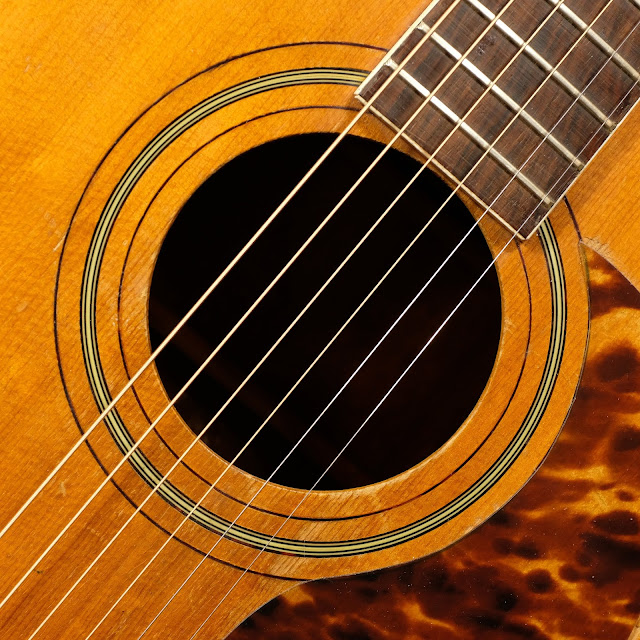1969 Harmony H1260 Sovereign Jumbo Guitar
There always seem to be a few H1260s hanging-out in the consignment racks. A local friend asked me to get one ready for him to try out, and since the consignor had a slot open, I put it in the workflow. This one has a date-stamp inside that puts it at 1969 and it's a pretty good example of these, tonewise. There's a good, rumbly bass that's not wooming -- but moreover it has a thick handful of mids and a clean treble.
People who only know Harmony boxes from word-of-mouth and cheap, student guitars tend to be surprised that the Sovereign line was made from good stuff -- solid spruce tops, multi-ply bindings, rosewood bridges and fretboards, and solid mahogany backs, sides, and necks. I tend to think that H1260s sound best open-tuned, but for the right player they make great general-purpose guitars.
Work included: a neck reset, fret level/dress, new pickguard, conversion of the tieblock/classical-looking bridge to a pin-bridge, new saddle slot and new bone saddle, and pinholes aligned with the saddle with new ebony pins. The neck is straight, it plays on-the-dot with 3/32" EA and 1/16" DGBE action at the 12th fret, strung with 52w, 40w, 30w, 22w, 16, 12 gauges.
Scale length: 25 1/8"
Nut width: 1 3/4"
String spacing at nut: 1 1/2"
String spacing at saddle: 2 1/4"
Nut width: 1 3/4"
String spacing at nut: 1 1/2"
String spacing at saddle: 2 1/4"
Body length: 19 3/8"
Lower bout width: 16 1/8"
Upper bout width: 12"
Lower bout width: 16 1/8"
Upper bout width: 12"
Side depth at endpin: 4 3/8"
Top wood: solid spruce
Back/sides wood: solid mahogany
Neck wood: mahogany
Fretboard: rosewood
Back/sides wood: solid mahogany
Neck wood: mahogany
Fretboard: rosewood
Neck shape: 10" or 12 " radius with medium, C profile
Bridge: rosewood
Nut: original plastic
Saddle: new bone, compensated
Weight: 4 lb 0 oz
Condition notes: it's crack-free, though the finish definitely shows weather-check and general wear-and-tear throughout. The pickguard is a replacement that I cut off of an original H1260 shape and I've converted the bridge to pin-style load. My main concern with this guitar is that the truss-rod is adjusted to its fullest extent. The neck is straight under tension, but if you were to string it more heavily and it needed adjustment, you might be out of luck.
When this came in, someone had cut and installed a saddle that was 1 1/2" longer on either side of the original saddle slot -- weird, right? Anyhow, conversion to a pin-bridge and fresh, drop-in saddle slot meant I could get the intonation right, the strings have better break-angle on the saddle, and it has a lot more adjustment room for changing action height during future setups.
The heel cap is a replacement, too.


















Comments